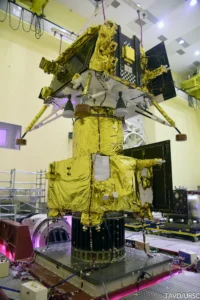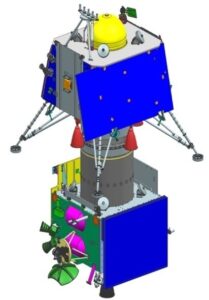The launch of Chandrayaan, India’s first lunar mission, on October 22, 2008, was a key turning point for the country’s space research efforts. In order to better comprehend Earth’s natural satellite, the mission’s goal was to investigate the moon’s surface and collect crucial scientific data. Although Chandrayaan had both achievements and disappointments, its influence on India’s space programme and the international scientific community is still felt today.

Chandrayaan-3 Launch Date
Before going to know Launch date we need to look back on ISRO’s Moon missions
Chandrayaan 1: Successes of Chandrayaan
The successful insertion of Chandrayaan into the lunar orbit on November 8, 2008, was one of the mission’s key accomplishments. With this, India joined the select group of countries allowed to send out and control spacecraft in the asteroid belt.

Terrain Mapping Camera (TMC) photographs of the lunar surface were taken in high resolution by Chandrayaan, one of the scientific instruments it carried. With the help of these photographs, several craters and lava tubes were found as well as other useful insights about the moon’s topography.
Moon Mineralogy Mapper (M3), an instrument on the mission, found evidence of water molecules on the moon’s surface, confirming the presence of water there. The prevalent view of the moon as a dry celestial body was challenged by this discovery, which was a ground-breaking revelation.
Chandrayaan’s X-ray Spectrometer (C1XS) successfully identified and mapped a number of substances that were present on the lunar surface. The composition of the moon and the evolution of its geology have been better understood as a result of these findings.
Facing Obstacles and Failures
An issue with the spacecraft’s power system caused Chandrayaan’s two-year mission, which was scheduled to terminate on August 29, 2009, to end early. Even with this setback, the mission had already succeeded in achieving a sizable chunk of its scientific goals.
Communication Breakdown
The loss of contact with the spacecraft on August 29, 2009, presented Chandrayaan with another difficulty. The information amassed up to that time, though, was priceless and made a significant contribution to our understanding of the moon.
Inspiring future generations to pursue lasting contributions and endeavours A new generation of Indian engineers and scientists were motivated by Chandrayaan’s accomplishments. Future missions were made possible by it, which also served to showcase the country’s capabilities in space exploration.
Future Projects and Lasting Contributions
Motivating New Generations A new generation of Indian scientists and engineers were motivated by Chandrayaan’s achievement. It proved the country’s aptitude for space exploration and prepared the path for upcoming missions.
Chandrayaan-2’s groundwork
Chandrayaan-2, India’s second lunar mission, which launched in July 2019, benefited much from the experiences and lessons learnt from Chandrayaan.

An important turning point in India’s space exploration history was the ambitious Chandrayaan-2 lunar mission. The mission, which was launched on July 22, 2019, had three main objectives to achieve a soft landing on the lunar surface; carry out scientific investigations; and improve our knowledge of the geology and composition of the moon. Despite both triumphs and setbacks, Chandrayaan-2’s influence on India’s space programme and the international scientific community is still felt today. In this article, we’ll examine Chandrayaan-2’s accomplishments and weaknesses while highlighting the key takeaways.
Chandrayaan-2: Successes include the following
Launch and Lunar Orbit Insertion Chandrayaan-2’s successful launch and subsequent insertion into the lunar orbit showed India’s capacity to carry out challenging space missions. India’s most potent rocket, the Geosynchronous Satellite Launch Vehicle Mark III (GSLV Mk III), was used for this mission to launch the spacecraft towards the moon.
Orbiter Performance
The Chandrayaan-2 orbiter successfully maintained its lunar orbit while using its cutting-edge scientific instruments. It contributed to our understanding of the moon’s composition and evolution by offering useful information on mapping the lunar surface, mineralogy, and the lunar exosphere.
Vikram Lander Descent
The Vikram lander, which was carrying the Pragyan rover, successfully disengaged from the orbiter and started to descend to the lunar surface. The achievement of India’s first-ever soft landing on the moon was made possible by this, which was a momentous step.
Problems and setbacks
Lander Communication Loss
On September 7, 2019, just prior to the Vikram lander’s anticipated touchdown, communication was lost while the mission’s descent phase was proceeding as scheduled. The mission’s goal of a smooth landing was severely hampered by this terrible incident.
Future Improvements and Lessons Learned
For India’s space programme, the communication failure with the lander yielded insightful information and lessons. It brought attention to the difficulties involved in lunar landings and helped pinpoint areas where navigation, guiding, and communication systems could be made better for upcoming missions.
Future Projects and Long-Term Contributions
Orbiter Operations and Data
Despite the Chandrayaan-2 lander failure, the orbiter is still in operation and is gathering important data. By giving researchers new information on the moon’s environment, surface, and minerals, it has continued to advance the anticipated mission’s duration.
Inspiring Work and Upcoming Projects
A new generation of engineers and scientists in India and other countries have been motivated by Chandrayaan-2. The accomplishments and difficulties of the project have strengthened the country’s will to carry out Chandrayaan-3 and further lunar missions in the future.
The eagerly awaited Chandrayaan-3 lunar mission from India is set to carry on the country’s aim of scientific moon exploration. This mission shows India’s persistent dedication to expanding its space programme by building on the accomplishments and lessons acquired from ChaEOdrayaan-2.
Chandrayaan 3
Chandrayaan 3 seeks to achieve a number of important goals
Soft Landing
After the failure of Chandrayaan-2, the mission aims to accomplish a successful soft landing on the lunar surface. India’s aptitude for lunar exploration will be shown by a successful landing, which will also provide important information for research.
Rover and Payloads
Chandrayaan-3 will carry a rover and payloads intended to investigate the lunar surface, research its geology, and acquire vital information regarding the moon’s composition and mineral resources.
Technology Demonstration
The mission will test novel systems and technologies, enhancing India’s space capabilities and paving the way for upcoming lunar missions.
The orbiter will act as the primary spacecraft for Chandrayaan-3, orbiting the moon and supporting communication between the Earth and the lander and rover.
Lander and Rover
Like Chandrayaan-2, Chandrayaan-3 will use a lander and rover technology. The rover will go across and investigate the moon, gathering important data for scientific analysis, while the lander will ensure a secure touchdown on the lunar surface.
Chandrayaan-3 Launch Date
On July 12, 2023, Chandrayaan-3 is expected to be launched. The launch will take place from the Satish Dhawan Space Centre in Sriharikota, Andhra Pradesh, India, according to the Indian Space Research Organisation (ISRO). Closer to the launch day, ISRO will disclose the precise launch window and timings.
Chandrayaan-3 carries a lot of promise for India’s space program and scientific research, as well as for the future. A successful mission will not only demonstrate India’s technological might but also add significant knowledge about the geology, mineralogy, and potential for resources on the moon. Chandrayaan-3’s knowledge-gathering efforts will further India’s space exploration efforts and maybe pave the way for missions to more distant celestial bodies in the future.
The scientific community in India is excitedly anticipating Chandrayaan-3’s launch, while space fans worldwide are anticipating the mission’s successes. Chandrayaan-3 is an important new step in India’s lunar exploration programme with its goals of completing a successful soft landing, undertaking rover-based exploration, and testing new technology. Watch for Chandrayaan-3’s launch on July 12, 2023, as India pushes the boundaries of space research and continues to try to understand the secrets of the moon.
We are wishing ISRO good luck for Chandrayaan 3 mission.
Great